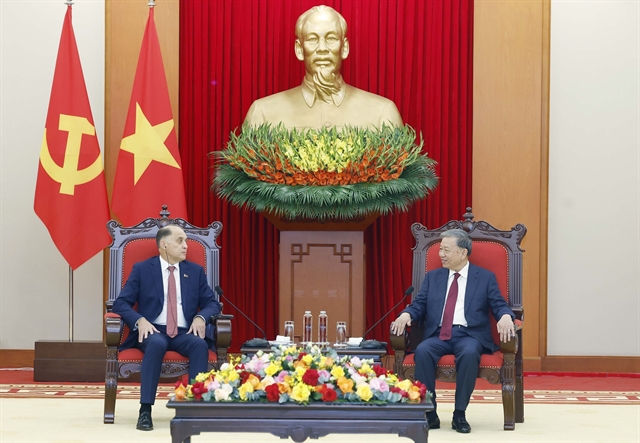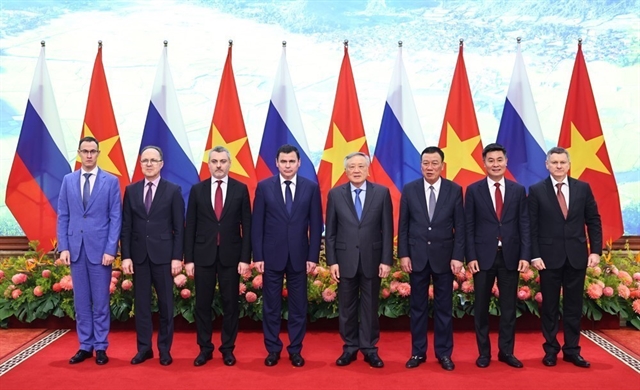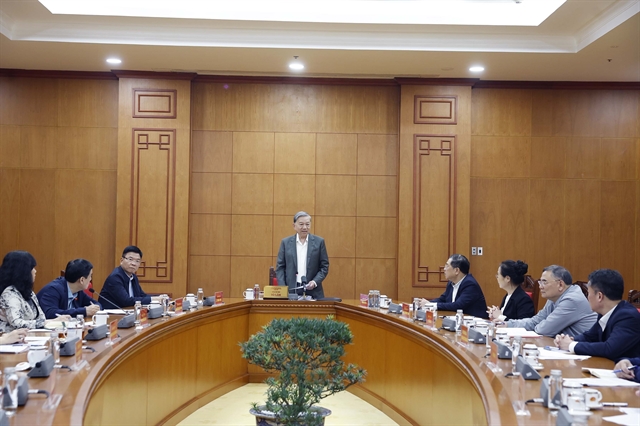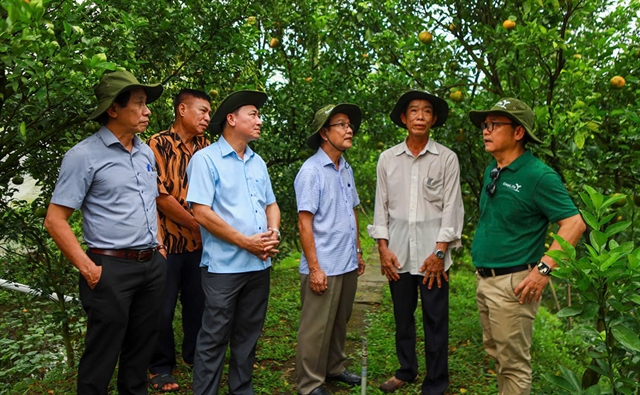 Society
Society
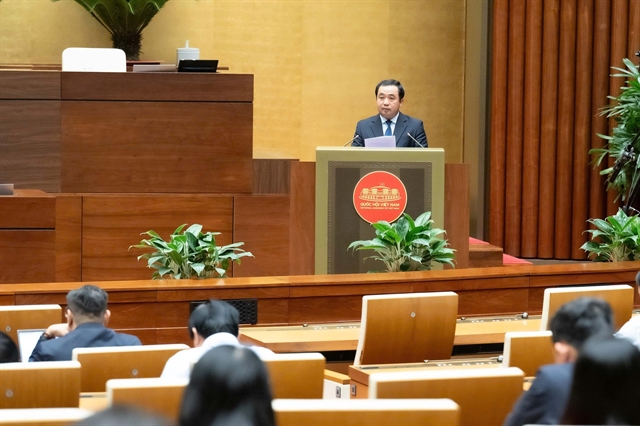
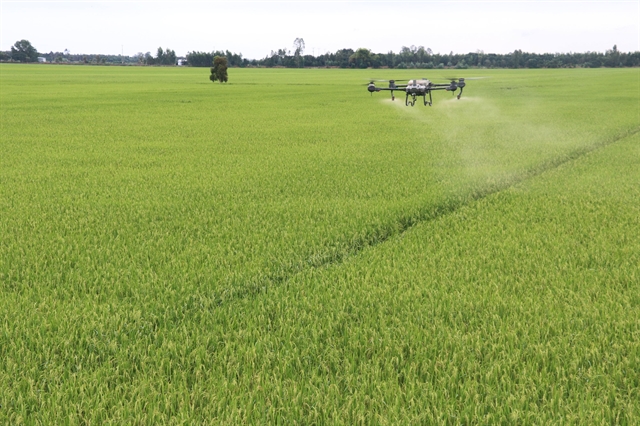 |
| A drone is used to spray pesticides on rice fields in Cao Lãnh District in Đồng Tháp Province. – VNA/VNS Photo Nguyễn Văn Trí |
ĐỒNG THÁP – Đồng Tháp Province has implemented digital transformation in agriculture to improve management and production efficiency.
It is one of the largest rice-producing provinces in the Cửu Long (Mekong) Delta.
According to its Department of Agriculture and Rural Development, the application of Internet of Things (IoT) and remote sensing technology in agricultural production has helped farmers better monitor their fields and optimise cultivation processes.
The province has established 17 smart pest monitoring stations and 33 smart water monitoring stations to inspect the quality and levels of irrigation water.
It has also developed 14 automatic sluice systems and smart pump stations each and 20 automated sluices for irrigation besides building 30 smart soil nutrient measuring stations.
Nguyễn Vũ Văn Minh, director of the department, said these facilities collect data automatically and synchronise it with the Việt Nam Digital Agriculture Platform Ecosystem.
He noted that this integration helps the agricultural sector centrally manage production, coordinate activities effectively and make prompt decisions to address pests and climate change.
He added that it also enables farmers to access modern technology, proactively manage water resources, prevent and control pests, and optimise their cultivation processes.
Tháp Mười District is one of the province’s localities that has strengthened its implementation of IoT and remote sensing technology in agricultural production.
Đoàn Thanh Bình, chairman of the Tháp Mười People’s Committee, said the district has adopted effective digital farming models such as rice fields that use advanced farming techniques, efficient irrigation and smart pest and environment monitoring systems.
The models also include fruit farming, which employs an automatic irrigation system and other advanced techniques, which are implemented by co-operatives.
Ngô Phước Dũng, director of the Mỹ Đông II Agriculture Co-operative in Tháp Mười, said the co-operative grows 570ha of rice and has established smart pest monitoring stations.
He noted that its members can monitor pests in their fields via mobile phones and implement integrated pest management in the early stages of the crop cycle, which helps protect the natural predators of rice pests.
The co-operative has also installed a water monitoring system to collect data on water, salinity and pH levels, supporting the effective production of three rice crops per year.
To boost digital transformation, the department has guided 62.6 per cent of farmers in the province on how to apply IoT in their production, use the internet to access market demand and supply information, and advertise and sell products online.
The province now has 20 farmers’ clubhouses using IoT in their production.
In co-operation with companies, the department has piloted the collection of agricultural production data through remote sensing technology to evaluate land use in the province, inspect periodic forest fluctuations, and monitor rice plant growth.
High-quality rice production
Đồng Tháp is implementing the Ministry of Agriculture and Rural Development’s project to develop one million hectares of high-quality, low-emission rice cultivation associated with green growth in the Mekong Delta by 2030.
It became one of the four provinces in the delta, besides Cần Thơ City, chosen by the ministry to pilot the project last year.
Farmers in Đồng Tháp participating in the project have achieved better production efficiency.
Võ Thanh Hải, a farmer in Tháp Mười District, said that under traditional farming methods he experienced low yields and was concerned about pests and climate change.
“After participating in the project, I was instructed to adopt new farming methods, grow high-quality rice varieties and use organic fertilisers and biological pesticides.
“Thanks to these changes, my rice yield has increased significantly and its quality has improved.”
Trần Tấn Đặng, another project participant in Tháp Mười, said: “I am impressed with the application of advanced techniques in rice production. With modern machinery, I can reduce labour significantly, save costs and increase productivity. Field management software also helps me monitor rice growth and make more accurate decisions.”
The province has developed 17 rice farming models under the project, covering a total of 1,573ha.
One of these was implemented by the Thắng Lợi Agricultural Service Co-operative in Tháp Mười on 43.1ha owned by 20 farmers during the last autumn-winter rice crop.
These farmers received 50 per cent subsidy on seeds, fertilisers and materials for decomposing straw and stubble, used machines for sowing and spraying pesticides and were provided with guaranteed outlets.
Production costs dropped by 20-30 per cent, yields increased by 10 per cent and profits rose by 20-25 per cent.
Nguyễn Văn Hùng, director of Thắng Lợi, said although it was initially difficult to sign up farmers for the project, many eventually contacted the co-operative on their own after witnessing improvements in rice quality and yields.
He said the co-operative has expanded its rice-growing area under the project to 150ha during the ongoing winter-spring crop.
Nguyễn Phước Thiện, deputy chairman of the province People’s Committee, said to develop sustainable rice cultivation under the project, the province would reduce rice seed usage to 80–100 kg per hectare and reduce the use of chemical fertilisers, pesticides and irrigation water by 20 per cent compared to traditional methods.
He said rice fields under the project would implement at least one sustainable farming method like “one must and five reductions,” alternate wetting and drying irrigation and the Sustainable Rice Platform.
The “one must and five reductions” approach requires the use of certified seeds while reducing the use of seedlings, nitrogenous fertilisers, plant protection chemicals, water use, and post-harvest losses.
Thiện said all rice fields under the project would be managed through linkages between companies, co-operatives, cooperative groups, and other farmer groups, with more than half employing machinery for cultivation.
The province aims to reduce post-harvest losses by 10 percent compared to traditional methods, collect and repurpose 70 percent of straw and stubble and lower greenhouse gas emissions by 10 percent.
It also seeks to increase the added value of these rice fields by 30 per cent, boost profits by 40 per cent and ensure that their exports account for 20 per cent of all exports from specialised rice growing areas.
It will invest in infrastructure in specialised rice growing areas, upgrade irrigation works, canals and roads to secure water for irrigation, facilitate the movement of rice-growing machines and improve the transport of harvested rice.
The province is also establishing networks of warehouses, rice dryers and processing facilities to create favourable conditions for companies to link up with farmers.
This year the province aims to expand the rice farming area under the project to 50,000ha and has registered with the ministry to increase it to 161,000ha by 2030. – VNS

